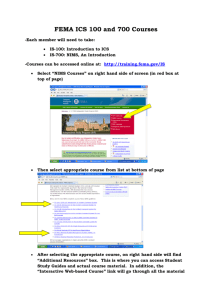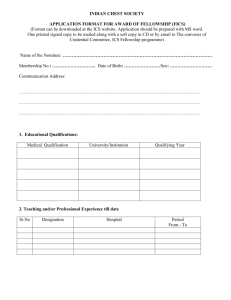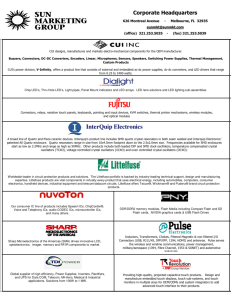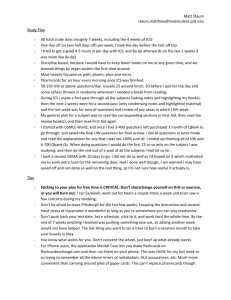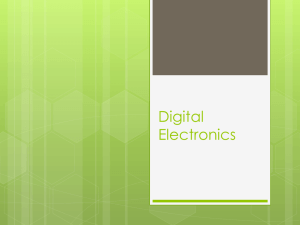Henrik Carling
advertisement
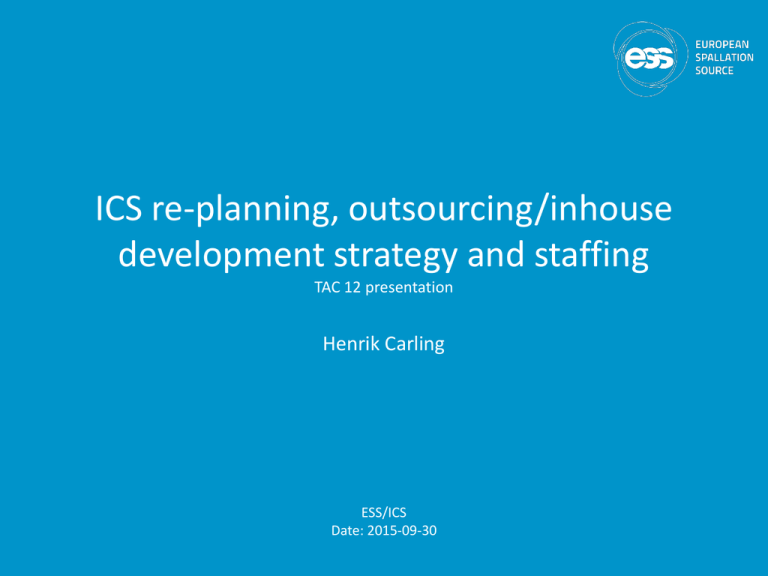
ICS re-planning, outsourcing/inhouse development strategy and staffing TAC 12 presentation Henrik Carling ESS/ICS Date: 2015-09-30 Re-planning, outsourcing/inhouse development strategy and staffing • Agenda – Current situation • Planning -> Effort estimate -> Competence/capacity roadmap • The challenge of in-kinding labor • Management of commercial suppliers – Issues – Way forward 2 2016 plan/budget result • Total A fairly detailed plan/budget for 2016 is available 14000000 12000000 10000000 • For some workpackages, it is a major revision of the planning. The most common problem is the low availability of stakeholder requirements meaning uncertain scope 8000000 6000000 4000000 2000000 • 0 The plans for 2017 and onwards are (with few exceptions) untouched since 2013/2014 timeframe. This means that visibility for activities after 2017 are obscure 25000000 • Plans for 2016 show that we must produce about twice the value that will be done in 2015 20000000 Physics Integration - Target Integration - Conventional facilities • For 2017 another value doubling is planned 15000000 Test Stands Integration - Instruments Personal safety system Control system infrastructure Software Applications Machine protection system • Management and administration 10000000 The ICS budget envelope for the construction phase shows the monumental challenge of fast rise and fall in capacity over just a few years time Integration - Accelerator Hardware core Software core Equipment 5000000 0 2015 2016 2017 2018 2019 3 Employee/consultant ratio • Since it is not currently possible to establish a credible competence / capacity roadmap, some other models can be used to establish the relationship between employees and consultants ICS staffing models (constant budget) 70 60 50 40 Consultants • One important factor is the size of the ICS team at steady state operations (somewhere in the phase 2019 - 2026) Employees 30 20 10 • Based on experience from other facilities and adjusting for ESS Size and complexity, the following model has been used as an estimate for the steady state operations phase Group 0 2015 2016 Employees Infrastructure 4 Integration 7 Management 3 Safety and protection 7 Software 9 2017 2018 2019 4 The challenge of in-kinding labor Organization Bilbao Bilbao Estonia TUT France CNRS Huddersfield IFE Legnaro PSI Saclay Saclay Saclay Saclay UK STFC Uppsala Uppsala Uppsala ZHAW Title MEBT controls MEBT controls Electronics collaboration Integration Support WP.10 Control Boxes Control Room design DTL controls Electronics collaboration LEBT controls Proton Source Proton Source and LEBT RFQ ontrols Procurement for PSS Control System Control System Control System MPS interlock Estimate Agreed Project status Contractual status 570 130 Early discussions to identify opportunities in testing 600 2000 1100 500 700 260 390 150 600 1850 175 150 100 Activities postponed to 2H 2016 Pre-study made and delivered. Pending contracts Technical annex being drafted. HOA being discussed assisted by Marie-Louise Collaboration is ongoing - investigation started how to In-kind this work 260 390 150 Technical annex signed Technical annex signed Technical annex signed Activities postponed to 2H 2016 Activities postponed to 2016 - coordinate with Accelerator Activities postponed to 2016 - coordinate with Accelerator Activities postponed to 2016 - coordinate with Accelerator Collaboration is ongoing - investigation started how to In-kind this work • • • • • The in-kind budget model is particularly difficult for ICS since 80 - 90% of the cost is labor driven This means that approximately a value of 25 M€ shall be generated from In-kind activities This corresponds to approximately 231 MY with the ESS Cost-book labor rate Meaning that approximately 58 in-kind FTE:s shall be fully loaded by ICS activities during 2016-2019 This is very, very difficult • We expect the ”value efficiency” to be quite low for in-kind activities 5 Management of commercial suppliers • Competence is one of several important factors for line managers to consider • Social skills and overall team and motivation level are sometimes more important (since skills often can be learned more quickly than behavioural changes) • When extending the line organization, one of the first decision points is if the position is permanent or transient • Permanent positions should be filled with employees considering – – – – • Transient positions can be filled with temporary employees or consultants – • Long term (5 - 10 years) assignment, competence and capacity profile of the team Social/teamwork skills Competence and experience Remuneration and other contractual status New framework agreements are being created • Software development services • Hardware development services • PLC programming services • Integration services The new framework agreements are intended to replace the current ”Epics integration” agreement – – – – Increase supplier selection Provide local support for smaller assignments Increase supplier competitiveness Lower cost, increase quality 6 Technology scope for ICS Electronics hardware Test and validation Availability, performance Databases Applicatoins (GUI, Web, Services) CSS/Eclipse EPICS Development environments Operating systems (RT) Kernel drivers Industrialization, maintenance Test and validation PCB, packaging Digital communication FPGA firmware Digital electronics The span of technical scope and the competencies needed in ICS is enormous From analog signals to Java-based high-end, big-data GUI:s in high performance, high availability PLC systems Mechanics and Safety/protection systems Systems integration, Installation Project management and administration Analog electronics • • • • • • Software PLC Mechanics Safety and protection 7 Competence map for ICS • • • • • • • • • • Electronics (Test, general) Digital systems (FPGA, Firmware) Automation and control (PLC) Computer communications (Networking, cabling) Hardware/software interaction (Low level software) Core software development (Linux kernel) Software development (Java) Database, High availability (Postgres) Systems integration Safety and protection systems (IEC61508 etc) 8 Software development services framework Requirements The European Spallation Source ESS AB is an accelerator-driven neutron spallation source. The Integrated Controls Systems (ICS) is responsible for providing control and monitoring for all parts of the machine (accelerator, target, neutron scattering systems and conventional facilities). A large part of the construction scope for ICS is to design, develop, test, deploy and maintain software systems. The software for the control system of ESS is distributed over many different products and technologies with a very wide scope. Some examples are: • • • • • • Control system core functions; the ESS software control system will be based on the open-source standard EPICS [Link] family of projects Hardware drivers; specialized hardware built specifically for ESS need software drivers, most often drivers in the Linux kernelspace Database oriented systems for configuration management; most user level ESS projects are built on database technology, common examples use PostgreSQL or similar open database products Operator environments; Providing ESS operators with a user interface environment for the control system is essential for ICS. We will use the Control System Studio [Link] family of open-source, Eclipse-based products for this purpose Development environments; in order for ESS stakeholders to be able to integrate efficiently into the EPICS-based control system, ICS will provide ready-made development environments to facilitate integration work Data acquisition, archiving and analysis; ICS needs be able to register and store signal flow in the control system to be able to debug and analyze/optimize problems in the very complex facility 9 Software development services framework This “OCT” has been issued by ESS AB in order to enter into a Framework Agreement with one supplier, and for a maximum period of 4 years from contract signature, for the following products: • Software development services including the following – Design • • • – Requirement breakdown and analysis Estimations Software architecture, data structure • • • Analysis Documentation Programming – – – • Java, C, C++ Linux environments, Embedded environments Test driven development Database implementation • • – Many methodologies from agile to waterfall Planning and structuring software projects Coordination of production/deliveries from several sites Software architecture Coaching and training Useability and design support • • User interface design analyses User experience design support Test, validation, verification and integration • • • • – Software methodology services including the following – Software project management support Implementation • • • – • Several different levels (module, system, integration, …) Build systems, automated testing Continuous integration Delivery The following products are excluded: • Automation software development (PLC) Deployment, maintenance and support 10 Issues • Very difficult to achieve the in-kind goals as labor • Long lead time for framework agreements to come into play • Uncertainties around the steady-state operations staffing situation 11 Thank you! • Questions 12

